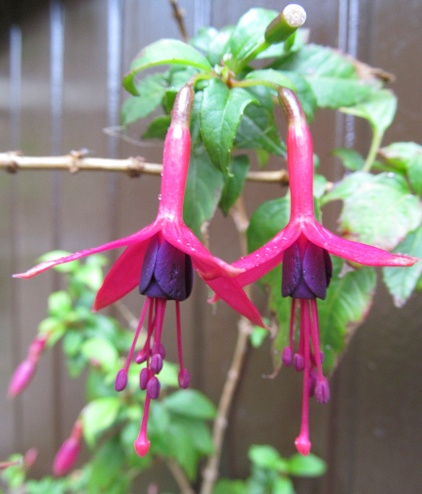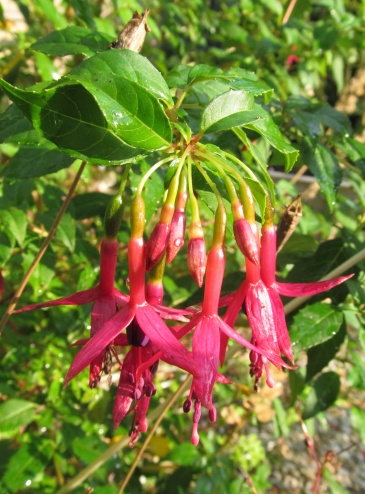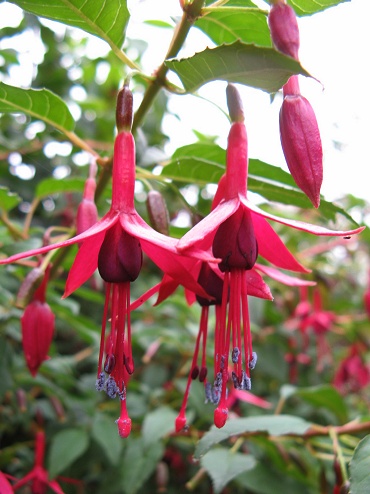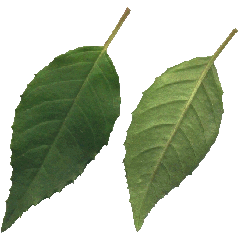
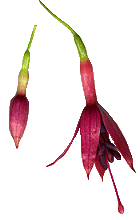

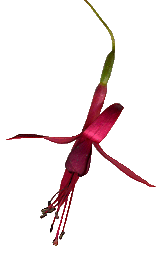
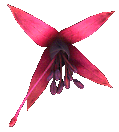
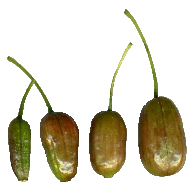
Lechlade Magician - Wright J.O. 1985 UK O E roodpaars-top groen donkerpurper / B S redpurple-t.green darkredpurple
(Whiteknights Amethyst - Wright J.O. 1980 UK O E roodpaars-top groen roodpaars / B S redpurple-t.green redpurple)
Ouders / Parentage : F. magellanica var. molinae x F. excorticata (F2-hybrid)
(Whiteknights Amethyst: Ouders / Parentage : F. magellanica x F. excorticata)
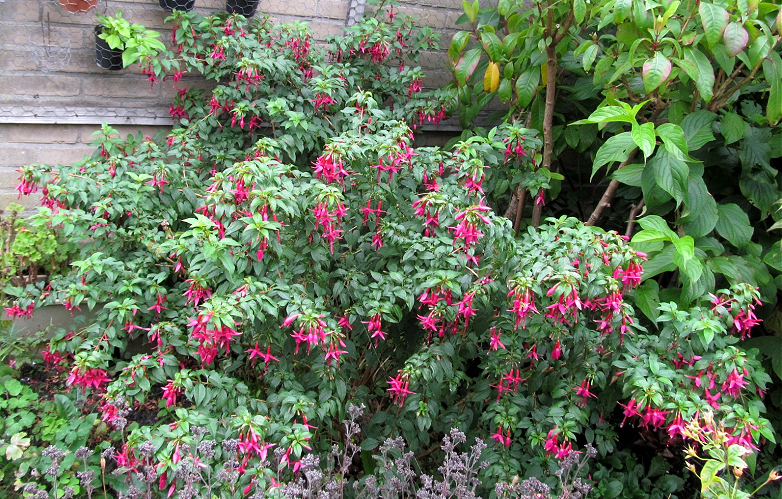
'Lechlade Magician' kan in korte tijd uitgroeien tot een forse, brede struik / 'Lechlade Magician' can become a big, wide bush in a short time
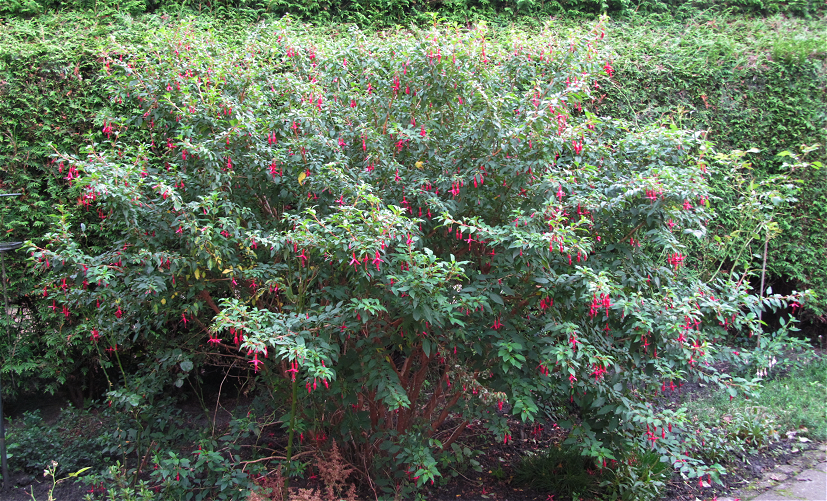
'Lechlade Magician' is een heel sterke, goed winterharde struik die rond de millenniumwisseling bij mij een zeer aarzelende start had, uit een stekje waar alle blaadjes waren afgevallen en dat ik zuchtend weg zou gooien. Onder de grond zaten echter gezonde wortels en groene puntjes, zodat ik het nog maar een kansje gaf...
Sindsdien is het misschien wel de sterkste, meest forse fuchsiastruik die ik heb. Hij lijkt op de magellanica's waar hij van afstamt, maar wordt groter en hoger in korte tijd. Mijn buurman had een exemplaar van mij gekregen (zie hierboven), en realiseerde zich niet dat hij 'm beter bij de grond kon afsnoeien in de winter, zodat de plant dankzij de zachte winter van 2013/14 in zijn kleine tuin uitgroeide tot een gigantische struik van minstens 2 meter hoog en ongeveer 3.5 meter breed. Hij had er meteen zů genoeg van dat hij de struik rooide - de vrij donkere kleine bloemen vond hij ook al niet echt mooi.
De buitengewoon sterke groei valt misschien te verklaren uit de vader van deze plant: de Kotukutuku, Fuchsia excorticata, een botanische soort uit Nieuw Zeeland die ook metershoog kan worden. Van deze interessante ouder die zelfs een eigen naam heeft in de Maori-taal, heeft 'Lechlade Magician' ook zijn mooie helderblauwe stuifmeel.
Of ik hier werkelijk te maken heb met 'Lechlade Magician' is trouwens niet 100% zeker, want hij heeft een look-alike van dezelfde Engelse veredelaar J.O. Wright, nl. 'Whiteknights Amethyst'. Hoeveel ik ook heb gepuzzeld wat precies de verschillen zijn, ik ben er niet uitgekomen. Beide hebben dezelfde vader Fuchsia excorticata, de moederplant van 'Whiteknights Amethyst' is simpelweg de rood-met-paarse F. magellanica, terwijl die van 'Lechlade Magician' de witte F. magellanica alba var. molinae is.Foto's komen ook zoveel overeen dat ze niet echt van elkaar te onderscheiden zijn.
Waarom ik denk dat ik 'Lechlade Magician' heb, en niet die andere? Omdat ik deze stek onder een verkeerde naam kreeg, nl. 'Lechlade Tinkerbell', maar die kan het niet zijn omdat die veel kleinere, lichtere Encliandra-bloemen heeft en totaal andere kruisingsouders, nl. Fuchsia arborescens x Fuchsia thymifolia. Echter wel een 'Lechlade', dus vandaar.
Bovendien is mijn plant amper gevoelig voor roest, ook als vele fuchsia's eromheen hier last van hebben, terwijl ik ooit in een open tuin een exemplaar onder de naam 'Whiteknights Amethyst' zag staan dat totaal onder de roest zat.
Daar komt nog bij dat in de officiŽle beschrijving van de plant bij de NKvF staat dat 'Lechlade Magician' een "milde bloei" vertoont (zoals ook mijn plant), terwijl 'Whiteknights Amethyst' een matige bloeier zou zijn.
'Lechlade Magician' is a very strong winterhardy bush that had a somewhat hesitating start with me around the year 2000, from a tiny cutting losing all its leaves, so that I decided to throw it away. However, under the soil I found some healthy roots and a few green tips which I gave another chance...
Ever since it's probably the strongest, biggest fuchsia bush I've ever had. It looks like the magellanicas it decends from, but it's growing higher and bigger in a short time. I gave my neighbour a specimen (see above picture), and he didn't realize he'd better cut it down to the ground when winter came, so that the plant in his small garden grew into a gigantic bush of at least 2 m high and about 3.5 m wide after the mild winter 2013/14. He didn't want it anymore and uprooted it.
The vigourous growth may be explained by the fact that the plant's father, Fuchsia excorticata, is a species from New Zealand growing up to 5 m high. From this interesting parent even having a name of its own in Maori language: Kotukutuku, 'Lechlade Magician' also inherited its clear blue pollen.
If my plant really is 'Lechlade Magician' is not quite certain, because it has a look-alike called 'Whiteknights Amethyst', from the same hybridizer J.O. Wright. However much I tried to find out what exactly would be the difference between the two cultivars, I did not succeed. 'Whiteknights Amethyst' has the same father Fuchsia excorticata, its mother is just red-and-purple Fuchsia magellanica, that of 'Lechlade Magician' is the white F. magellanica alba var. molinae, but their flowers have the same colours and shape. Photos are so much alike that none could show any difference to me.
The reason why I think it should be 'Lechlade Magician' is that I got it under a wrong name: 'Lechlade Tinkerbell', which can't be right because that one has small pinkish Encliandra flowers and its parents are Fuchsia arborescens x Fuchsia thymifolia. But it was a 'Lechlade', and therefore this seems more likely.
Another reason is the fact that even in the worst rust-years my plant is only lightly susceptible to rust, while I saw a specimen called 'Whiteknights Amethyst' covered in rust somewhere in an open garden.
Moreover, in the official list of the NKvF (the Dutch Fuchsia Society) 'Lechlade Magician' is described as a profuse flowerer (like mine), while 'Whiteknights Amethyst' would be moderate in bloom.
